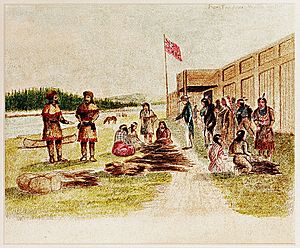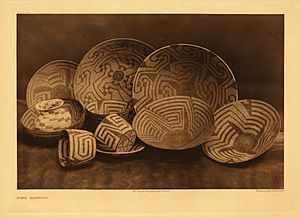Indian Trade facts for kids
The Indian Trade describes the historic exchange of goods between Europeans and their descendants in North America, and the Native peoples of North America. This trade began even before European colonies were fully established. It continued through the 1800s and slowly ended around 1937.
The name "Indian Trade" refers to the people involved in these exchanges. The types of goods traded changed depending on the area and the time period. In much of Canada, this trade was mostly about furs. Furs, especially beaver fur for making beaver hats, were very valuable to Europeans.
Europeans also wanted other items. They traded for deerskins in the southeastern United States. On the Great Plains, they sought buffalo skins, meat, and pemmican. Native Americans also had their own demands, which influenced what goods Europeans brought to trade.
Economic connections between Native Americans and European settlers started early. From the 1600s to the 1800s, the English and French mainly traded animal pelts and furs with Native Americans. Trade between the Spanish and Native Americans was less common and only lasted for a few decades.
Over time, wars and a decrease in Native American populations changed things. The United States expanded westward, leading to tribes being moved to reservations. This largely ended the old ways of trading between Native Americans and European Americans.
However, other economic activities continued. Today, many Native American arts and crafts are shared and sold. Some Native American tribes now run gaming casinos on their reservations. These casinos are often entertainment resorts, bringing in money for tribes. This money helps with economic growth, welfare, and education for their people.
The first European explorers to trade with Native Americans were Giovanni da Verrazzano and Jacques Cartier. This happened in the 1520s to 1540s. Verrazzano wrote that if they wanted to trade, Native people would come to the shore. They would send items on a rope, shouting for the Europeans not to come too close. As more Europeans visited and settled, Native peoples began regular trade with them. Good places for fur trading were often near harbors where ships could easily dock.
Contents
Early Trade with European Settlers
Plymouth and Jamestown Colonies
To build successful colonies, settlers needed resources like land, labor, and tools. Trading with Native Americans often gave colonists important knowledge and natural resources. This happened in the English settlements of Plymouth Bay and Jamestown.
Massasoit, a leader of the Wampanoag people, and Squanto, a Patuxet who helped as a diplomat, assisted the Pilgrims of Plymouth Colony. They taught the Pilgrims how to farm the land and hunt. In return for weapons and tools, these Native Americans provided food and other resources.
In 1621, Massasoit signed an early trade agreement with Plymouth Colony. This treaty aimed for peaceful trade. However, as more colonists arrived in New England, the Wampanoag worried about losing their land. Tensions grew, leading to King Philip's War. This war ended with the Native tribe's defeat, damaging relations between the Pilgrims and Native Americans.
Relations between settlers in the Jamestown area and Native Americans ended similarly. The Powhatan initially helped the English settlers with food and clothing. This helped the colonists survive their difficult early years. But after three years, relations worsened, leading to war.
The Fur Trade Business
Fur trading was a major economic activity in North America from the late 1500s to the mid-1800s. At that time, there was a huge demand for fur in Europe. Furs were used to make clothing and fashionable hats. For example, over 20 million beaver hats were sent from England alone between 1700 and 1770.
Both Native Americans and Europeans benefited from the fur trade. Hunting beavers in Europe was very difficult because the animals were almost extinct there. But in North America, traders thought there were endless animals. Native Americans used the goods they received, especially knives, axes, and guns. The fur trade gave many Native Americans a steady income.
However, by the mid-1800s, fashion trends in Europe changed. Also, the beaver population in North America declined. These changes caused the demand for fur to collapse.
Trade with the Spanish
Trade between Spanish settlers and Native Americans was not common. It mostly happened in parts of New Mexico and California. The Spanish mainly wanted to spread the Christian faith and set up a system called encomienda.
The most important effect of Spanish trade was the introduction of the horse to the Ute in New Mexico. Horses soon spread across the Great Plains. This greatly changed the lives of many Native American tribes. Many tribes switched from hunting and gathering to a nomadic lifestyle. Horses allowed them to hunt bison over a wider area and trade more easily with other tribes.
How Europeans and Natives Related
It took time for Europeans and Native Americans to understand each other's customs. When Europeans first met a tribe, they were often offered furs, food, or other items as gifts. Europeans did not always understand that these gifts meant they were expected to form an alliance. This included helping the Native people against their enemies.
Native American tribes often gave gifts as part of their social customs. Because many Europeans did not do this, they were sometimes seen as rude.
After seeing that Europeans wanted to trade goods for skins and other items, Native Americans joined in. Both sides then became involved in each other's conflicts. In places like New France, Carolina, Virginia, and New England, Europeans were drawn into the ongoing wars of their trading partners. Native Americans also felt pulled into European wars, such as Queen Anne's War and the Seven Years' War. These were conflicts between European powers like France, Great Britain, and Spain.
Later Trade and Today
After the United States became independent, it passed laws to control trade with Native Americans. The first of these was the Indian Intercourse Act in 1790. Later, the Natives Office issued licenses to traders in the Native Territory.
Many large tribes from the Southeast and north of Ohio were moved west of the Mississippi River. By 1834, "Native Territory" included most of what is now Arkansas, Kansas, and Oklahoma. Other Native tribes still lived in the upper West. Traders from Mexico and mountain men operated there freely, outside of U.S. control.
The U.S. Constitution gave Congress the power to "regulate Commerce with foreign Nations, and among the several States, and with the Native tribes." In the 1800s, the American government passed laws to move tribes to reservations. This allowed their lands to be sold to European Americans. The Indian Removal Act of 1830 forced tribes like the Cherokee and Choctaw to leave their homelands.
Native American resistance to moving led to conflicts, such as the Second Seminole War. Forcing tribes to move to isolated reservations, often with poor land, made many dependent on the U.S. government for supplies. They found it hard to develop their own economies.
On reservations, tribes often lacked access to money and skilled workers. They were also given areas with poor natural resources, or their resources were taken from them.
Today, many programs exist to help reservations become independent and financially strong. One example is the Harvard Project on American Indian Economic Development. Since the late 1900s, many tribes have opened gaming casinos. The most successful ones use some of their earnings to help their nations grow economically. They also use the money for welfare and education for all tribal members.



